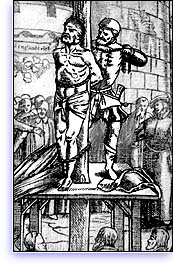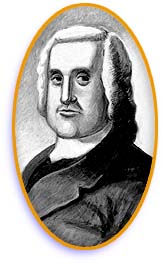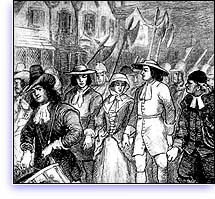
While religious liberty is probably the most important American contribution to the science of government, and while the United States symbolizes religious tolerance and freedom to the rest of the world, this very freedom has come under assault time and time again. In fact, here in this bastion of freedom, people have been persecuted, imprisoned, beaten and even killed for their faith.
This has, of course, been a situation in many countries for thousands of years. Courts have pronounced individuals “guilty” because of their faith and, after “trials,” the guilty have been thrown to lions, burned at the stake, banished, beheaded or hung.
Perhaps there has been no period more synonymous with persecution and injustice than the Inquisition, when tribunals established in Spain, Portugal and other countries imprisoned many innocents for life, sentenced hundreds to death by burning and even pursued people after their deaths, tearing up graves and confiscating property. Jews and Moslems were frequent targets and, as one historian noted, “the Inquisition in Spain destroyed Protestantism in its germ.”
In contrast with conditions in Europe, America emerged as a shelter from religious oppression in various forms. Massacres of Roman Catholics under “Bloody” Mary in England and persecution of Protestant dissenters there and in other European countries drove many people to the shores of the New World. The Founding Fathers, concerned with ensuring religious freedom in the new nation, forged that concept into the First Amendment, the cornerstone of the Bill of Rights.
Worse, it is so deep-seated that it is often invisible to all but the victim. It is, for example, “accepted practice” to view certain denominations as “cults,” with the derogatory connotations this term implies. It is “acceptable” to believe that false information from opponents of these denominations is true, and to dismiss true data given by the denomination about itself as false.
Instead of bringing about justice, the actions of courts can, and do, lead to injustice.
Prejudice among the judiciary permeates “judgments” which ruin the lives of men, women and children who are innocent of any crime. The resulting sensationalized media stories stir up families, neighbors, colleagues and schoolmates, and perpetuate bigotry and discrimination.
Attacking religious individuals whose opinions may not be politically correct is nothing new. From Pontius Pilate to kings and queens of the Middle Ages to present day, history is littered with the casualties of prejudice.

 In the 15th and 16th centuries in England, when clergy were fighting to maintain their monopoly over Christ’s message, when the Bible was in Latin and the general populace was not educated in Latin, when the monarch ruled by “divine right,” religious intolerance was a way of life in the country, the king’s Court and the judiciary.
In the 15th and 16th centuries in England, when clergy were fighting to maintain their monopoly over Christ’s message, when the Bible was in Latin and the general populace was not educated in Latin, when the monarch ruled by “divine right,” religious intolerance was a way of life in the country, the king’s Court and the judiciary.
Once the Reformation began, courts were used as a vicious tool by those in power.
Sir Thomas More, immortalized in “A Man For All Seasons,” fell victim to a court exploited by King Henry VIII for his own ends. Lord Chancellor under the king, More was devoted to the Pope and the Catholic Church. When Henry began to wrest control of the English branch of the church from Rome, More resigned. When he warned against heresy and refused to deny papal supremacy, More was committed to the Tower of London, then brought to trial on charges of treason and on a count that he had denied to the Solicitor General the king’s title of “supreme head of the Church of England.”
More defended himself on the charges of treason before the court, but refused to acknowledge the king’s new title.
He was beheaded within days.
Not only was the rule of law compromised because law could be changed at the whim of the king according to his own agenda, but an accused person had no protection in the courts, as they normally consisted of men with political aspirations that depended upon the sovereign’s favor.
 Contemporary with More, religious reformer William Tyndale translated into English the New Testament and the first five books of the Old Testament. He made these available to the general English populace for the first time in history and thereby cut across the interests of the established church, which until then had maintained its position as sole interpreter of the word of God.
Contemporary with More, religious reformer William Tyndale translated into English the New Testament and the first five books of the Old Testament. He made these available to the general English populace for the first time in history and thereby cut across the interests of the established church, which until then had maintained its position as sole interpreter of the word of God.
The clergy were naturally appalled and outraged at this erosion of their authority and vigorously demanded he cease his activities.
Tyndale was arrested, imprisoned for more than a year and a half, then tried for heresy, condemned, strangled and burned at the stake the same year More was beheaded.
Staunch Church of England supporters such as priest Hugh Latimer, Bishop of London Nicholas Ridley and Archbishop of Canterbury (the most senior ecclesiastical post in the Church of England) Thomas Cranmer were charged with heresy and sent to the Tower of London.
Upon their refusal to accept Catholic doctrine, they were condemned as heretics.
Imprisoned for more than a year, when they still refused to recant, Ridley and Latimer were burned at the stake. Just before the fires were lit they were given one last chance to save their lives. They refused again. Latimer’s last words: “Be of good comfort, Master Ridley, and play the man. We shall this day light such a candle, by God’s grace, in England, as I trust shall never be put out.”
Cranmer was induced to acknowledge the authority of the Pope for a while, but ultimately repudiated his supposed recantation, in public defiance of his captors. He too ended his life at the stake.


By the mid-1600s, Englishmen were no longer burned at the stake for having the “wrong” religious beliefs — but they still went to prison.
George Fox, founder of the Society of Friends, was arrested 36 times, and spent six years in jail. Between 1650 and 1689, 3,000 of his followers were imprisoned for their beliefs; many were tortured.
William Penn, an early Quaker follower, was jailed in the Tower of London for his book, Innocency with Her Open Face, which expounded his views on the Trinity. Upon being informed that he would be freed if he recanted, he stated, “My prison shall be my grave before I will budge a jot, for I owe my conscience to no mortal man.”
He was later released, but the following year, when the Quaker meetinghouse in London was closed by authorities, Penn was arrested on trumped-up charges of fomenting a riot when he preached in the street. At Penn’s trial, after he showed the baseless nature of the charges against him, the jury rejected a guilty verdict — only to then be fined and imprisoned themselves. So much for the objectivity of the courts.

In 17th century America, pilgrims and settlers who had fled Europe for religious reasons often perpetrated the same intolerance they had suffered.
The early years of the colonies contain many examples of religious persecution. Lutherans, Quakers and other religious minorities were arrested, sentenced, fined, whipped and banished.
Three years later, Boston authorities ordered everyone in Massachusetts to take an oath of loyalty. Williams refused on the basis that an oath sworn in the name of God mixed the two worlds. He maintained that no government had the right to demand an oath. He was put on trial before the General Court of Massachusetts, and banished from the colony.
When England adopted the Act of Toleration in 1689, conditions alleviated for most Protestants in the colonies, but Catholics, Jews, Unitarians and other non-Protestant faiths continued to suffer persecution.
And so it continued as “new” or minority religions found themselves targeted by those in power — usually those of older, larger religions.
The Church of Jesus Christ of Latter-day Saints and its members, for example, suffered persecution from the start. Within two years of Joseph Smith starting the church, a mob broke into his home, seized him while he slept, dragged him out of the house, beat him severely, choked him into unconsciousness, then tarred and feathered him. Those responsible were never brought to justice.
In July 1833, Mormons in Missouri were targets of a hate campaign to drive them out — not because they had broken any laws, but because of prejudice.
 “Concerned citizens” demanded that no more Mormons be allowed to settle in the area, that those already there must leave, that they must cease to publish their newspaper and shut down all businesses.
“Concerned citizens” demanded that no more Mormons be allowed to settle in the area, that those already there must leave, that they must cease to publish their newspaper and shut down all businesses.
The judge of the county court, along with two justices of the peace, led a mob of 500 against them. Although the Mormons hired attorneys to present their case, their actions in court further inflamed the mob. As it was clearly impossible for them to obtain justice, they were forced to leave their homes and businesses and resettle in a different county.
Five years later, they were faced with the same situation. Plied with false information from troublemakers, mobs once again attacked. Avowed anti-Mormon Lilburn W. Boggs was governor and their appeal to him for help fell on hostile ears. His reply: “The quarrel is between the Mormons and the mob, and they can fight it out.”
But when the Mormons moved to defend themselves, Boggs ordered their extermination. “The Mormons must be treated as enemies, and must be exterminated or driven from the state if necessary for the public peace,” he said.
All avenues of justice that should have been available were shut.
Joseph Smith and other Church leaders were thrown in prison. A “court-martial” sentenced them to be shot at sunrise the next morning. Only the refusal of the man ordered to carry out the murders saved their lives.
Forced to flee once again, the Mormons attempted to win compensation and redress for the losses they had suffered in Missouri, to no avail.

